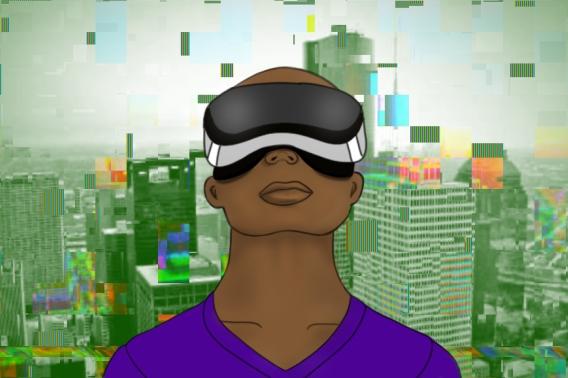How VR could help treat depression

Today, we're going to talk about virtual reality and how it could be used to treat depression.
We're talking with psychiatrist Kim Bullock, the founding director of Stanford's Neurobehavioral Clinic and Virtual Reality & Immersive Technologies (VRIT) program, and a clinical professor in the Stanford Medicine Department of Psychiatry and Behavioral Sciences.
Dr. Bullock calls herself a "radical behaviorist." Like other practitioners of cognitive behavioral therapy (CBT), she sees the troublesome thoughts and emotional states of many psychiatric disorders as just another form of behavior, which can be reshaped through self awareness and practice — much like you might work at avoiding junk food or not biting your nails.
Of course, one of the biggest challenges is the practice part. It's no easy task for patients to practice experiencing the world in a more positive, healthy way. This is why Bullock is eager for CBT practitioners to embrace virtual reality technologies — which enable psychiatrists to prescribe precisely calibrated "experiences" to treat cognitive & behavioral disorders.
We started by discussing early results from a clinical trial for a virtual reality-enhanced intervention major depressive disorder, which Dr. Bullock recently launched with support from the Wu Tsai Neurosciences Institute Neuroscience:Translate program.
Join us to learn more about how VR is transforming the world of psychotherapy!
SUBSCRIBE on Apple Podcasts, Spotify, Amazon Music and more.
Learn more
- Imagining virtual reality as a simple tool to treat depression (Stanford Medicine, 2024)
- Extended Reality(XR) enhanced behavioral activation for treatment of Major Depressive Disorder (2022 Neuroscience:Translate grant)
- Clinical Trial: Virtual Reality Behavioral Activation: An Intervention for Major Depressive Disorder
- The Stanford Virtual Reality and Immersive Technologies (VR-IT) Program
- Recent VR-IT publications
Episode Credits
This episode was produced by Michael Osborne at 14th Street Studios, with production assistance by Morgan Honaker. Our logo is by Aimee Garza. The show is hosted by Nicholas Weiler at Stanford's Wu Tsai Neurosciences Institute.
If you're enjoying our show, please take a moment to give us a review on your podcast app of choice and share this episode with your friends. That's how we grow as a show and bring the stories of the frontiers of neuroscience to a wider audience. You can also send us an email at neuronspodcast@stanford.edu.
Episode Transcript
Nicholas Weiler:
Welcome back to From Our Neurons to Yours from the Wu Tsai Neurosciences Institute at Stanford University. I'm your host, Nicholas Weiler.
Today, we're going to talk about virtual reality and how it could be used to treat depression.
We've talked a lot on the show about the growing movement to think about psychiatric disorders like depression as neural circuit problems. As we discussed with Nolan Williams last year, if you know what circuit is misfiring, you might be able to bump that particular network back into a healthy functional range.
But another equally important frontier in the world of psychiatry relates to adapting insights from neuroscience into talk therapy to help give patients cognitive tools to evaluate and shape their own thoughts and behavior.
You may have heard of cognitive behavioral therapy or CBT. It's been around for decades but has evolved into the most widely accepted evidence-based and effective form of psychotherapy out there. Basically, it takes insights from neuroscience and psychology about how to shape behavior and applies them to the realm of thought or cognition. CBT recognizes that thoughts and emotions are just another form of behavior which can be reshaped in a similar way. Therapists help you practice being mindful of your problematic mental state, identify your cues and triggers, and practice mental skills of responding to those triggers in a more productive way.
This approach is wildly successful, but one of the biggest challenges is the practice part. Let's say you're afraid of heights or of spiders, or let's say you experience debilitating anxiety about presenting your work to colleagues. These are experiences that are hard to practice in the safety of a therapist's office. This is why CBT practitioners are eager to embrace the rise of virtual reality technologies, which allow patients to practice simulated experiences and behaviors in a controlled and repeatable way.
So to learn more about how VR is potentially transforming the world of psychotherapy, this week, we're talking with Dr. Kim Bullock.
Kim Bullock:
My name is Kim Bullock. So I am a full clinical professor in the Department of Psychiatry and Behavioral Sciences, and then I direct the neurobehavioral clinics and Virtual Reality and Immersive Technology Clinic.
Nicholas Weiler:
Well, Dr. Bullock, I'm really excited to talk with you about how VR can be used in psychiatry and also, more broadly, what you see as the meaning of the efficacy of this technology for how we think about psychiatric disorders because I think that VR has sort of a reputation as being a little bit frivolous. I personally very much enjoy a game of VR mini golf. So if any listeners care to have a game of mini golf, I'm there for that.
Kim Bullock:
I know. That game is good. I will.
Nicholas Weiler:
It's a great way of chatting with people.
Kim Bullock:
It's one of the best games out there in the VR space.
Nicholas Weiler:
I agree. I agree. But you've used VR for a couple of applications, and you have a recent study that I think is a good way into this conversation. So this is a study looking at virtual reality in a group of patients with depression. And I wonder if you could just give us the overview of what you did there and why VR seemed to be a helpful tool for these patients.
Kim Bullock:
Yeah. So we decided to do a study that we thought would be most impactful because there's 30 years of efficacy and studies on the application of VR and enhancing mostly anxiety disorders, PTSD, panic, social anxiety, and there's emerging evidence for psychosis, primary psychotic disorders and substance abuse and eating disorders. But there was really a wide gap and vacuum for mood disorder, especially major depressive disorder. So we thought about, "Well, what could we do with our time that would be most impactful?"
Major depressive disorder is a public health issue. We're in a kind of state of crisis here with it being the second leading cause of death in young adults, and there's been hardly anything done on this. So we thought, "How could we enhance evidence-based psychotherapy using VR for patients with major depressive disorder?" So there are basically five different psychotherapies that have been found to be efficacious, and they're as efficacious as medications. But the advantage of psychotherapies is that they have better durability.
So when you stop doing the therapy, you still are better. You have a less chance of relapse. Where if you stop the medication, you're going to more likely to relapse. So we thought the most simplistic form of therapy is behavioral activation. It's basically getting people to do more pleasant activities, and you get them scheduling them, tracking them, working through the barriers because a lot of depression ends up in this vicious cycle of being depressed and avoiding activities, and then you get more depressed, and then you avoid more. So it's a way out of that cycle.
Nicholas Weiler:
Yeah. We talked a little bit about this with your colleague Neir Eshel on the show a little while ago. Part of some forms of depression, this sort of challenge of motivation, challenge of being able to initiate things even if they sound like they would be fun. I wonder if we could take a step back. So are you saying that behavioral activation is, for many people, equally efficacious with medication or psychotherapy?
Kim Bullock:
It is.
Nicholas Weiler:
And it sounds so simple. I mean, I guess my reaction to it is a little bit that it's what you sort of worry about with someone who's suffering from depression that people might just say like, "Well, why don't you just go outside and do something, right. Get out of your room and go do something." And that's not a very empathetic response. But how do you frame this in a different way?
Kim Bullock:
Yeah. Well, and there's challenges. It's easy to do, but that's why sometimes the cognitive therapy really is ultimately in the service of changing behavior. But to be honest, it isn't trivial. There's barriers. Older people have lost people that they love, and they used to do pleasant activities with or those relationships that would give them joy. And so, yeah, I don't want to oversimplify it at all. So I'm glad you're bringing up that point because we don't want to stigmatize an already stigmatized problem.
Nicholas Weiler:
So you had this study in which you used VR in a group of patients with depression to lower the barrier essentially to getting out into the world to having some fun experiences. So I wonder if you could introduce this for people who maybe have never thought about using virtual reality in the context of clinical depression.
Kim Bullock:
Yes, and I do want to say this is a proof of concept. I can't say without a shadow of a doubt that this is efficacious for all people with depression, and we need larger studies. But I mean, what we did was basically simulate pleasant activities, and they seem to be not inferior to in real-life IRL activities when you assign them in behavioral activation.
There's probably multifactorial things going on. Our last study, the most recent one, we compared traditional behavioral activation to VR-enhanced or XR-enhanced using a Quest headset and free choice about pleasant activities. And we found that both groups got better, almost equally better, but the group in the VR arm got better even before the treatment began, which tells me that maybe the placebo or the expectancy of using technology had some kind of effect. So again, we don't know what the causal mechanism was about why people actually get better.
Nicholas Weiler:
Can you tell us a little bit about some of the experiences that the people in your study went through?
Kim Bullock:
Well, I probably can't because a lot of it's free choice, but we had a list of possible programs they could choose from. These were just ideas to spur them. So there were different categories in travel. There was gaming. There was education. A lot of them liked actually the travel and the YouTube. That's what I'm hearing. That was the majority of the activities that people chose.
Nicholas Weiler:
And so people could choose anything really or from a list. And many of the activities that they chose had a similar effect essentially to this behavioral activation of going outside, doing pleasurable activities can help a lot of people get over that barrier in depression.
Kim Bullock:
And everybody's different. What floats one person's boats, something else for another.
Nicholas Weiler:
Right.
Kim Bullock:
So what's pleasure to one person can be an aversive to another.
Nicholas Weiler:
So I want to ask you, so you're the director of the Virtual Reality and Immersive Technologies program at Stanford, and I'd love to hear a little bit about your sort of broader sense of how virtual reality can be a tool for psychiatry. You're using this not just for depression.
You've worked a lot on functional neurological disorder, which used to be called conversion disorder. We've talked recently on the show with Carolyn Rodriguez, who's used virtual reality for hoarding disorder, helping people sort of get over some anxiety around getting rid of stuff. What makes virtual reality a powerful tool in psychiatry?
Kim Bullock:
Yes. So I didn't realize this, and this is what made me so excited about doing this and pivoting my whole career. There are so many applications, but you could kind of bucket them in four main categories at this point. The first one that was studied is cue. It helps with cue desensitization or habitation and normalization of that kind of amygdala arousal that often happens in so many anxiety disorders and trauma-based problems that people have.
Nicholas Weiler:
So if you have a fear of spiders or fear of heights or something, you can...
Kim Bullock:
Yes, it can simulate a cue and replicate it and be very specific, and it's accessible. So to get habituation and desensitization, you need to do usually exposures three times at least for 30 minutes or until your subjective units of distress go down by more than 50%.
How does somebody do that all day long? It's just not accessible, but you can repeat it in a virtual experience. So that's really important. And then the thing that I really am interested in is you can change implicit beliefs. I don't know if you've ever talked to Jeremy Bailenson about the Proteus Effect-
Nicholas Weiler:
No. Tell us about it.
Kim Bullock:
... that he discovered. Yeah. So these body transfer experiences, when you inhabit the body of an avatar and the characteristics of that avatar change your implicit beliefs about those characteristics after embodying that avatar. So, in a sense, it's like forced empathy.
Nicholas Weiler:
So what does that mean? Could you give us an example?
Kim Bullock:
Yeah. And they do a lot of this at work trainings for sexism or racism or any characteristics that are being discriminated against. So if you inhabit the body of someone with Brown skin and you're white skin, we all have implicit biases towards certain characteristics, even if you think that you don't.
So after you inhabit the body of somebody, let's say, in a different colored skin, you can see before and after that they have different biases. So it forces like an egocentric theory of mind shift that sometimes we can't do with intention. So what excites me most about it is that implicit belief changing that can occur when you have an experience that you can't just do by force talking about something.
Nicholas Weiler:
And it's interesting that you mention that. I mean, it's an experience. It's not just intellectual. It's actually embodied. You're embodied in a virtual space, and what did Dr. Bailenson call it? The Proteus effect?
Kim Bullock:
The Proteus Effect, yes.
Nicholas Weiler:
Right. So being able to change into another person essentially in the context of virtual reality can change some of those implicit beliefs. So that's very interesting.
Kim Bullock:
You can also use it for distraction for acute painful distress. When you have distress that you have to tolerate for a short period of time, we know that flooding that visual system can really block afferent pain and allows people to use less pain medications or get through something emotionally distressing that they wouldn't otherwise. So that's the other way it can be used.
Nicholas Weiler:
So that was accessibility sort of clinically. It's something that can be used logistically easily. There's potential for people to see themselves in a new light, and then there's this aspect of distraction that it can take you away from something negative or aversive. Those are sort of the four main things you're bringing up.
Kim Bullock:
I kind of think of exposure, distraction, training, and implicit belief shifting.
Nicholas Weiler:
I wonder if you could give an example because the next thing I want to talk about is, as a neuroscientist, what do we think is going on in the brain when something like a virtual reality experience is able to potentially alter our mood or potentially alter our behavior the way that we are interacting with people?
Kim Bullock:
Yeah. And again, we don't know, and we're discovering. So a lot of this we're just starting to gather the evidence for. But I mean exposure, when you think about it, is creating an experience that's different than your prediction, right. So you have to create this incongruence between what you predicted what happened and actually you observed what happened. So, in VR, you can really control and modulate what happens in an experience. It's very good at creating incongruent experiences that can help with habituation.
Nicholas Weiler:
So that's interesting to think about how these experiences might be changing the way people's brains work. I'd love to hear more about this treatment modality that you mentioned, behavioral activation. It sounds like there are a lot of different areas in psychiatry where this kind of approach could be valuable. I've seen conversations about addiction and in eating disorders, for example, in addition to depression.
Kim Bullock:
Mm-hmm.
Nicholas Weiler:
And one of the things I think is so interesting about the idea of virtual reality for psychiatric disorders is that, in a sense, it is a behavioral intervention for a behavioral disorder. Cancer is a cellular and chemical disorder, and we have cellular and chemical treatments for that. Many psychiatric disorders can be thought of as a disorder of behavior and cognition. And so something like VR is a way of having a controlled behavioral or cognitive intervention.
Kim Bullock:
Yes. So I'm a radical behaviorist because I do think we're so complex. You can't go down to the Petri dish and describe what's going on with a psychiatric illness. These are behaviors, and I really believe that most things are conditionable through both operant conditioning and classical conditioning.
Nicholas Weiler:
Two different classic ways of shaping behavior.
Kim Bullock:
Yeah. And that's the beauty of being human. We're so flexible and adaptable because we have this built-in algorithms that create all these different behaviors in the certain environments. And so you can use VR to leverage that to condition certain behaviors up or down, or however you'd like. So that's really, in a nutshell, what VR was probably going to be most used for.
Nicholas Weiler:
This is something that we haven't really talked about on the show before, is this idea of cognitive behavioral therapy. It seems like that is very congruent with what you were just saying about sort of radical behaviorism and with this idea of virtual reality as giving a controlled experience that can help condition us out of unhealthy behaviors or patterns of thought and into more healthy behaviors or patterns of thought. What is cognitive behavioral therapy, and why is it connected to this idea of virtual reality treatment?
Kim Bullock:
Yeah. Well, it is a type of therapy that's really looking at observing your thoughts, your behaviors, and your emotions and sensations and using a variety of skills and techniques to get self-control. And it's usually pretty directive, but there are many different schools of CBT too. So it's a huge topic. But within all of those, I think VR is going to be kind of just a modality, like a TV set or videos.
You can probably think of thousands of creative ways to use TVs or videos in whatever you're doing. So I don't think that it's limited, and it's only limited by our creativity about how we're going to use this, especially in CBT. But CBT seems to lend itself, I think, to this technology more easily, and the scientific clinical trials are more easily done with CBT.
Nicholas Weiler:
Right. Well, I wanted to sort of close with a question maybe for listeners. I'm sure that almost everyone listening probably knows someone with clinical depression or has experienced it themselves.
We talked about the study that we opened the episode with is a preliminary work exploring a new direction in using virtual reality to augment or make easier this idea of behavioral activation of allowing people with clinical depression to get out into the world, to try fun activities, maybe with a lower barrier than actually getting out of the house, which can often be very challenging.
So for people who have experienced depression themselves or who know people who are experiencing depression, what are some things coming out of this research that listeners could maybe share with a loved one who's experiencing this?
Kim Bullock:
Well, the main thing I think they need to know is most depression is very treatable and reversible, but only 60% of people with depression even show up for treatment. So whatever you can do to reduce the barriers to that treatment because there are obviously a lot of barriers, including stigma. So having treatments that involve something cool like virtual reality, I think, give it a respect too. We know this is a disorder. It kills people. It's serious. You need to address it, and there are treatments that really work.
But the other thing, even of the people who present for treatment, for some reason, only 37% of them actually get an evidence-based treatment. So one thing is to make sure you're getting an evidence-based treatment and ask for it. You don't have to just get meds. You can ask for therapy. A lot of times, people think that the first line is meds, and actually a lot of the times the first line should be therapy. So ask for therapy and also ask your providers to use it because, right now, the technology's there, the research is there for using VR to enhance psychotherapy.
But the biggest barrier are the providers. The acceptability is low in providers. So we need the consumers to demand, we need industry to give us easier solutions for the providers, and we need curriculums because there's a training gap for providers in learning how to use these skills and to feel like they have standard best practices. So I'd say consumers to ask for VR or ask for behavioral activation, ask for these things, and demand it.
Nicholas Weiler:
Yeah, I think just remembering that there are options and remembering that there might be more options than you've heard about.
Kim Bullock:
Yes.
Nicholas Weiler:
Yeah. Well, I look forward to hearing more about this work as it continues. And I'd love to learn more about some of the other things that you work on, like functional neurological disorder. But thank you so much for coming on the show. It's been a pleasure.
Kim Bullock:
Oh, yes. The pleasure's all mine. Thank you so much for doing what you do. It's a fascinating podcast. Really appreciate it.
Nicholas Weiler:
Thank you. Thanks again to our guest, Dr. Kim Bullock. You can learn more about her work in the show notes. If you're enjoying the show, please subscribe, share with your friends. It helps us grow as a show and bring more listeners to the Frontiers of Neuroscience. We'd also love to hear from you.
Tell us what you love. Tell us what you hate. Give us a comment on your favorite podcast platform, or send us an email at neuronspodcast@stanford.edu. From Our Neurons to Yours is produced by Michael Osborne at 14th Street Studios with production assistance from Morgan Honaker. Our logo is by Aimee Garza. I'm Nicholas Weiler at Stanford's Wu Tsai Neurosciences Institute. We'll see you next time.


